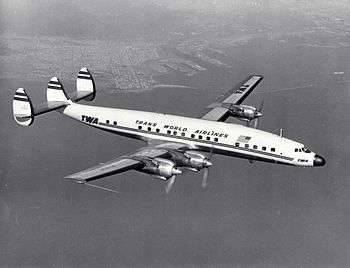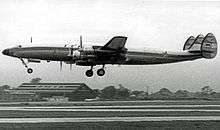Lockheed L-1649 Starliner
| L-1649 Starliner | |
|---|---|
 | |
| A Trans World Airlines L-1649A Starliner in flight. | |
| Role | Airliner |
| National origin | United States |
| Manufacturer | Lockheed |
| Designer | Clarence "Kelly" Johnson |
| First flight | October 10, 1956 |
| Introduction | June 1, 1957 |
| Retired | Early 1980s |
| Status | Retired |
| Primary users | Trans World Airlines, Lufthansa, Air France |
| Produced | 1956–1958 |
| Number built | 44 (Including prototype) |
| Unit cost |
US$3,000,000 (at the time) |
| Developed from | L-1049 Super Constellation |
The Lockheed L-1649 Starliner was the last model of the Lockheed Constellation line. Powered by four Wright R-3350 TurboCompound engines, it was built at Lockheed's Burbank, California plant from 1956 to 1958.
Design and development
Development of the Starliner began when Lockheed designed the L-1449 in response to the Douglas DC-7C Seven Seas.[1] Powered by four 5500 hp Pratt & Whitney PT2G-3 turboprop engines, the L-1449 would have cruised faster than the DC-7C but would have had comparable range with the 10,200 US gallon fuel capacity in a new 150 ft (46 m) wing. Pratt & Whitney dropped the PT2 project ca. March 1955 due to expected unreliability, high specific fuel consumption and high operating costs, though the T34 military version of the engine powered the Douglas C-133 freighter (which was also plagued with marginal reliability).
The Air-Britain book says the L-1449 would have been 55 inches longer than the L-1049 series with a maximum weight of 175,000 lb;[2][3] the L-1549 replaced the 1449 in early 1955 with an additional 40-inch stretch and a takeoff weight of 187,500 lb, presumably still with the big PT2 turboprops.[4]
However Rummel's book[5] says Lockheed told TWA on 30 September 1954 that the L-1449 would use the same fuselage as the 1049 series; Hughes Tool Co ordered 25 of them in December, though TWA estimated that the L-1449 would lose money for them even with every seat occupied. When P&W dropped their engine Lockheed proposed an L-1549 with Allison turboprops, but TWA and Lockheed agreed on the piston-engined L-1649 instead and so amended the L-1449 contract. In April 1955 Lockheed told TWA that they wanted to drop the 1649, but Hughes refused to agree.
Though the L-1449 and L-1549 were never built, all Constellations from 1954 onwards were strengthened to take the thrust generated by the T34/PT-2 turboprops, which were fitted to several R7V-2 Constellations for the United States Navy (USN).
With the abandonment of the L-1549, Lockheed designed a less ambitious upgrade of the Constellation series as the L-1649A Starliner. The new design used the L-1049G fuselage, the new 150 ft (46 m) wing and four Wright R-3350 988 TC18-EA-2 turbocompound radial engines, allowing the Starliner to fly nonstop from California to Europe.
"Lockheeds claim that their new airliner, powered by four 3,400 h.p. Wright Turbo-Compounds, will be capable of carrying 58 passengers for 6500 miles at a cruising speed of over 350 m.p.h. and that it will fly from Paris to New York in nearly three hours less time than the DC-7C when carrying the same payload as its Douglas competitor."[6] In January 1958 Pan American scheduled the DC-7C from Orly to Idlewild in 14 hr 15 min; TWA scheduled the 1649 in 14 hr 50 min.
Operational history
The L-1649A prototype first flew on October 11, 1956. (The prototype [N1649] was the property of Lockheed until the early 1970s when it was sold in Japan.) Airline service began on June 1, 1957 on a Trans World Airlines (TWA) flight from New York to London and Frankfurt. TWA called their L-1649s "Jetstreams" and flew them on longer domestic routes and on flights from New York to Europe and beyond. In July 1958 TWA scheduled 60 flights a week from Europe to New York; 30 were L-1649s, including seven nonstops a week from Paris, five from London, four from Frankfurt, two each from Madrid, Lisbon and Geneva, one from Zurich and one from Rome. Three 1649s a week flew the Polar route Europe to California, sometimes nonstop.[7]
Boeing 707s replaced the last TWA transatlantic passenger L-1649 in October 1961; 707s and Convair 880s displaced them from domestic scheduled flights in December 1962. In the early 1960s Lockheed converted twelve TWA L1649s to freighters that carried cargo across the Atlantic until 1964 and domestically until 1967.
Air France bought ten Starliners; they were the only airline to market the aircraft by its name (being called the "Super Starliner").[8] Transatlantic flights lasted from August 1957 until September 1960 when the 707 took over. Starting in April 1958 Air France L-1649s flew from Paris to Anchorage to Tokyo, but they were not allowed to fly to the west coast of the United States. In summer 1959 they scheduled 22 nonstop L-1649s a week from Orly to Idlewild, four of which continued to Mexico City; two weekly L-1649s flew from Orly to Montreal to Chicago Midway and back. The twice-weekly ORY-ANC-TYO flight was scheduled for 30 hr 45 min, compared to 42 hr 20 min for the fastest 1049G via India (and 32 hr 00 min for BOAC's Comet from London to Tokyo via India).

Lufthansa was the last airline to purchase the Starliner new; their four Starliners were marketed as "Super Stars" and flew transatlantic routes. Lufthansa's Starliners were delivered nonstop to Hamburg from the Lockheed factory at Burbank. In summer 1959 Lufthansa scheduled nonstops to New York from Frankfurt, Düsseldorf and Orly. Lockheed converted two of Lufthansa's Starliners to freighters after the Boeing 707 had replaced them on the transatlantic passenger flights in 1960.
LAI (Linee Aeree Italiane) ordered four Starliners but did not take them up following the merger with Alitalia in October 1957. Alitalia had accepted the DC-7C and had no interest in the Starliners; they were delivered to TWA in 1958. Varig ordered 2 Starliners, but the order was switched to two L-1049Gs.
The DC-7C ended up selling more airframes than the Starliner, which had greater range than its rival but was expensive ($3,000,000 USD) and entered service a year later. In the end, only 44 Starliners were built (including the prototype) compared to 121 DC-7Cs.
Alaska Airlines used two Starliners for MATS operations in the 1960s. Others operators used Starliners for charter flights. A small number of Starliners were used as cargo aircraft in Alaska during the 1970s. By the early 1980s, all Starliners ceased commercial operations.
Four Starliners still exist; Lufthansa is restoring one to flying condition.[9]
Variants
- L-1649A
- Initial production version powered by four Wright R-3350 988 TC18-EA-2 engines. 44 Built.[10]
- L-1649B
- Proposed turboprop version. None built.[11]
Accidents and Incidents
- June 26, 1959 - TWA Flight 891, crashed due to a lightning strike after taking off from Milan Malpensa Airport in Italy, with the loss of all 68 passengers and crew.[12]
- May 10, 1961 - Air France Flight 406, named "De Grasse" broke up in flight after empennage failure over the Sahara Desert, thought to have been caused by an explosive device, killing all 78 passengers and crew.[13]
Surviving aircraft
.jpg)
Four Starliners still exist.[14]
- N7316C (c/n 1018) at Auburn-Lewiston Airport in Maine is currently being restored to flying condition by Lufthansa. First flight of the restored aircraft is planned for sometime in 2017-2018 with the extensive restoration having been continuous since 2007.[15]
- N8083H (c/n 1038), also at Auburn-Lewiston Airport, is being salvaged for parts for N7316C's restoration.[16]
- N974R (c/n 1040) is on display, outside the Fantasy of Flight museum in Polk City, Florida.[17]
- ZS-DVJ (c/n 1042), currently in Trek Airways colours, is at OR Tambo International Airport, Johannesburg and is continuously threatened by the airport authorities to be scrapped if it is not removed from the airport grounds. The owners are currently struggling to find a means of moving the Starliner to a different location.[18]
Specifications (L-1649A)
Data from the SAA Museum Society website[19] and Lockheed Constellation:From Excalibur to Starliner.[20]
General characteristics
- Crew: five
- Capacity: 99 Passengers
- Length: 116.2 ft (35.1 m)
- Wingspan: 150 ft (45.72 m)
- Height: 23.4 ft (7.13 m)
- Empty weight: 91,645 lb (45,569 kg)
- Max. takeoff weight: 156,104 lb (70,800 kg)
- Powerplant: 4 × Wright R-3350 988 TC18-EA-2 radial, 3,400 hp (2,535 kW) each
- Propellers: Hamilton Standard Hydromatic 43H60 hollow or solid Dural Blade 3 bladed propellor
- Propeller diameter: 16ft. 10in. (5.13 m)
Performance
- Maximum speed: 377 mph (607 km/h)
- Cruise speed: 290 mph (467 km/h)
- Range: 4,940-6,180 mi (7,950-9,945 km)
- Service ceiling: 23,700 ft (7,225 m)
See also
- Related development
- Lockheed Constellation
- Lockheed L-049 Constellation
- Lockheed C-69 Constellation
- Lockheed L-1049 Super Constellation
- Lockheed C-121 Constellation
- Lockheed EC-121 Warning Star
- Aircraft of comparable role, configuration and era
- Related lists
- List of Lockheed aircraft
- List of models of the Lockheed Constellation
- List of Lockheed Constellation operators
References
- Notes
- ↑ Breffort, Dominique. Lockheed Constellation: from Excalibur to Starliner Civilian and Military Variants. Histoire and Collecions, 2006. p.112 to 117
- ↑ The Lockheed Constellation Series by Peter J Marson, Air-Britain 1982
- ↑ American Aviation 6 Dec 1954 p.29 says the 1449 would be 118.2 ft long while the 1049G was to be 113.6 ft; the 20 Dec issue says the 1449 cabin would be 55 inches longer.
- ↑ Aviation Week 4 April 1955 says P&W dropped the civil PT-2 after Lockheed lengthened the 1449 fuselage by 108 inches; "This longer version became the 1559."
- ↑ Howard Hughes and TWA by Robert W Rummel, 1991
- ↑ Flight International 10 June 1955 p.785
- ↑ Breffort, Dominique. Lockheed Constellation: from Excalibur to Starliner Civilian and Military Variants. Histoire and Collecions, 2006. p.117 to p.119
- ↑ Aviation Week 26 August 1957 p45 reports that Air France planned to fly a 1649 from Abbeville to Nice along the coast at 1000 ft altitude, having advertised the times it would appear at each point. The 2500-mile flight was to take just over nine hours.
- ↑ Lockheed Constellation Survivors - L1649A Starliner; Petersen, Ralph M. - Retrieved 11/5/10
- ↑ Breffort, Dominique. Lockheed Constellation: from Excalibur to Starliner Civilian and Military Variants. Histoire and Collecions, 2006. p.169.
- ↑ [US Warplanes - C-69/C-121 http://www.uswarplanes.net/c69c121.html] Retrieved 2/24/11
- ↑ ASN Aircraft accident Lockheed L-1649A Starliner N7313C Milano - Retrieved 11/5/10
- ↑ ASN Aircraft accident Lockheed L-1649A Starliner F-BHBM Edjele - Retrieved 11/6/10
- ↑ Lockheed Constellation Survivors - Constellation News; Various Authors - Retrieved 11/3/10
- ↑ Lockheed Constellation Survivors - Robert Pettengill (currently restoring this a/c) N7316C c/n 1018; Petersen, Ralph M. - Retrieved 11/3/10
- ↑ Lockheed Constellation Survivors - N8083H c/n 1038; Petersen, Ralph M. - Retrieved 11/3/10
- ↑ Lockheed Constellation Survivors - N974R c/n 1040; Petersen, Ralph M. - Retrieved 11/3/10
- ↑ Lockheed Constellation Survivors - ZS-DVJ c/n 1042; Petersen, Ralph M. - Retrieved 11/3/10
- ↑ SAA Museum Society - Lockheed L1649 Starliner - Retrieved 11/3/10
- ↑ Breffort, Dominique. Lockheed Constellation: from Excalibur to Starliner Civilian and Military Variants. Histoire and Collecions, 2006. p.175.
- Bibliography
- Breffort, Dominique. Lockheed Constellation: from Excalibur to Starliner Civilian and Military Variants. Paris: Histoire and Collecions, 2006. Print. ISBN 2-915239-62-2.
- Lockheed Constellation Survivors - L1649A Starliner; Petersen, Ralph M. Retrieved 11/5/10.
- California Classic Propliners - L-1649A Starliners; Gibson, Tom. Retrieved 11/5/10.
- US Warplanes - C-69/C-121. Retrieved 11/5/10.
External links
| Wikimedia Commons has media related to Lockheed L-1649 Starliner. |
- Lockheed Constellation Survivors—A website that explains information and whereabouts of surviving Constellations, including Starliners.
- YouTube - Lufthansa L1649 Lockheed Starliner Project Auburn Maine—A news clip about N7316C's restoration from 2009.